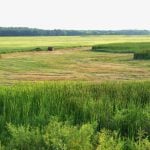Japan may soon open its border to beef from animals younger than 21 months, but finding suitable young cattle for that market could be an issue.
Without birth certificates showing the beef came from cattle younger than 21 months, graders must rely on physiological characteristics.
“Unfortunately, in the interim, if Japan opens the border in the next couple of weeks or months, we don’t have enough cattle out there going to slaughter that will have verifiable birth certificates with them,” said Wayne Robertson of Agriculture Canada, who was involved in a study to assess cattle age using physical indicators of maturity.
Read Also

Alberta rancher finds success with virtual fencing
Increased use of virtual fencing in cattle industry in Canada showcased at Innovation on the Range in Southern Alberta.
Until there are enough birth certificates, examining carcasses at grading is the next best indicator of age. Most certificates are for cattle born this year and they will not be ready for slaughter until late 2006 or 2007.
Dentition does not suffice as age verification in animals this young.
Researchers looked for signs of ossification in three main areas of the body where soft cartilage turns to bone as the animals mature. A score card of zero to five was developed and an animal passed if it scored less than two at each spot. Carcasses are removed from the group if there are signs of maturity.
The lumbar area, or mid back, was checked for small islands of ossification that start to form as the animal matures.
The thoracic vertebrae, where the carcass is split at the 12th and 13th ribs, is also checked for ossification. If it is clear, inspectors move to the sacrum in the tail bone. The segments in this area are separate but fuse as the animal matures.
The first part of the study started with cattle from Quebec because many had proof of age. The carcasses were checked at the Better Beef plant in Ontario at the regular processing speed that most large commercial facilities operate under.
The next part of the study needs at least 1,000 western cattle up to 24 months old to verify the process.
“The problem with the study is that we have had trouble finding cattle of a suitable age with verified birth date information still attached to them,” Robertson said.
Based on ossification scores, 80 to 90 percent of animals could be eliminated from the export stream using physical characteristics.
Among animals younger than 20 months with actual birth date information, only 20 percent were correctly identified by physiological maturity characteristics of the carcass based on evaluations of ossification.
The United States has a classification called A-40 that it believes the Japanese will accept. It takes into account bone maturity as well as lean meat colour and texture, width and roundness of the ribs. Few cattle have proven suitable.
“In their study, 93 percent of the carcasses that were based on their birth date would qualify but are eliminated by the A-40 criteria,” Robertson said.
Certain factors affect maturity scores, including growth hormone use, feed programs, breed, various management approaches and gender, because heifers mature sooner than steers.















